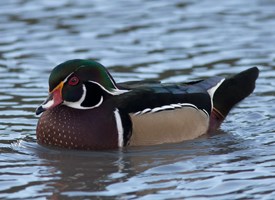
For many years my father, J.C.Reel Jr. made wood duck nesting boxes for Wood Ducks to use in our area. He was commisioned by the Texas Parks & Wildlife for the nesting boxes which were placed around Lake Mexia, TX.

The Wood Duck is one of the most stunningly pretty of all waterfowl. Males are iridescent chestnut and green, with ornate patterns on nearly every feather; the elegant females have a distinctive profile and delicate white pattern around the eye. These birds live in wooded swamps, where they nest in holes in trees or in nest boxes put up around lake margins. They are one of the few duck species equipped with strong claws that can grip bark and perch on branches. (Credit: From The Cornell Lab Ornithology.)
Cool Facts
- Natural cavities for nesting are scarce, and the Wood Duck readily uses nest boxes provided for it. If nest boxes are placed too close together, many females lay eggs in the nests of other females.
- The Wood Duck nests in trees near water, sometimes directly over water, but other times up to 2 km (1.2 mi) away. After hatching, the ducklings jump down from the nest tree and make their way to water. The mother calls them to her, but does not help them in any way. The ducklings may jump from heights of up to 89 m (290 ft) without injury.
- The Wood Duck is a popular game bird, and is second only to the Mallard in numbers shot each year in the United States.
- Wood Ducks pair up in January, and most birds arriving at the breeding grounds in the spring are already paired. The Wood Duck is the only North American duck that regularly produces two broods in one year.
- (Credit: From The Cornell Lab Ornithology.)
No comments:
Post a Comment